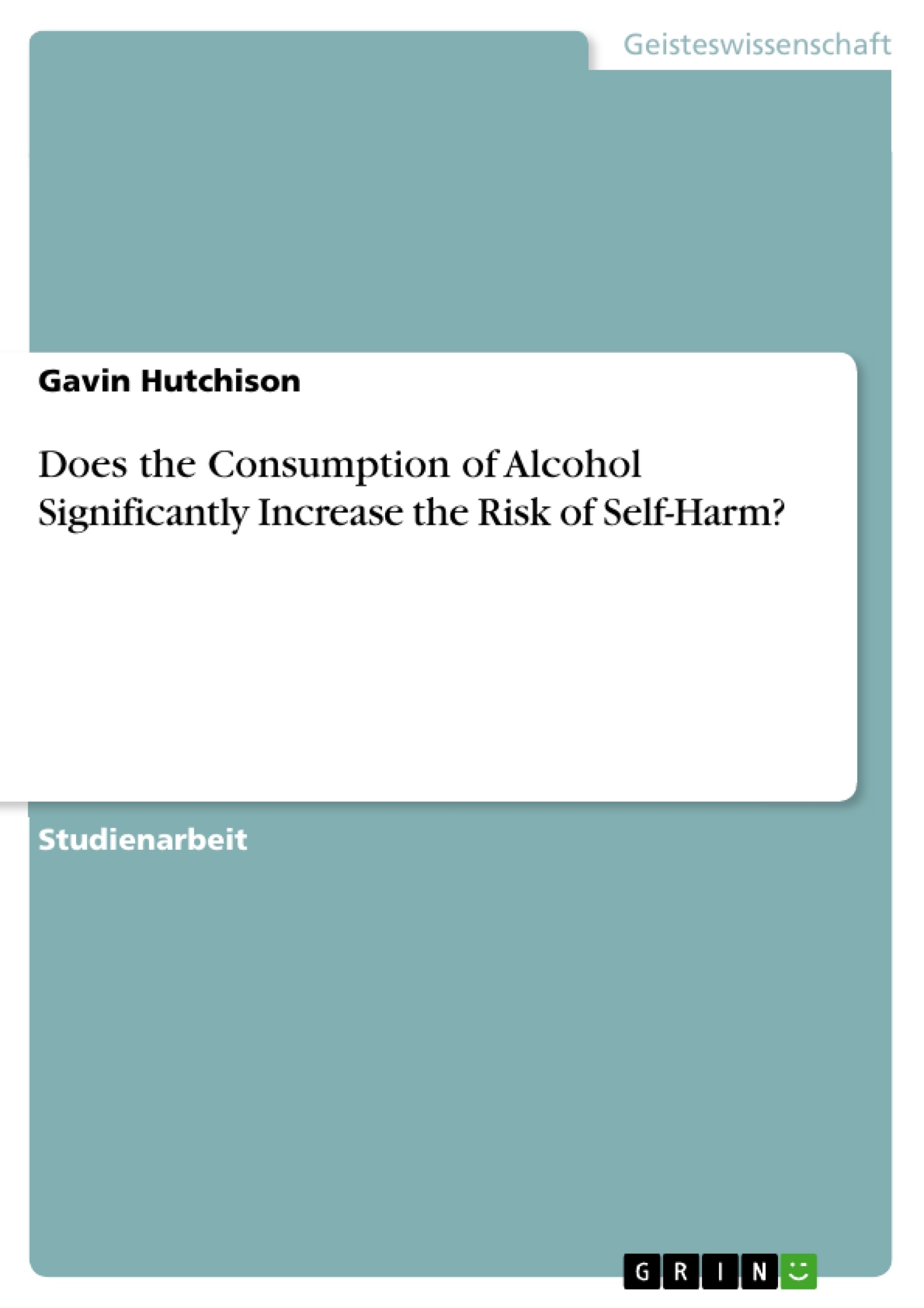This project examines whether alcohol significantly increases the risk of self harm. By examining clinical research in Oxford, Northern Ireland and Scotland a relationship has been established. The statistics paint a similar picture, indicating that alcohol significantly increases self harm in men, additionally it hints at possible regional variations in relation to consumption to alcohol and self harm. Alcohols disinhibiting effects are explored to explain alcohols role in self harm. Additionally sex, alcohol and self harm is researched to explain why more men are admitted to hospital with alcohol related issues when harming themselves. Alcohol, self harm and childhood trauma is also explored in relation to women. This project challenges the assumption that self harm is a female dominated phenomenon, and raises many questions.
Societal harm has been a major concern for the masses, with the health of the alcohol consumer a secondary concern. “Until recently it has been rare for any society to focus on alcohols effects on health as a criterion of state policy.” (Room, R. 1997) This harm comes in many forms, for example “short term effects such as a hangover, an injury, or an overdose, or long term effects such as liver cirrhoses...” (Room, R. 1997) This harm, along with self harm is seen as the responsibility of the individual. “[t]here is an obvious conflict in modern societies between the doctrine of consumer sovereignty and these increasingly exacting standards of care and attention...The solution...has been to place the burden of managing of the conflict (and the blame for failure) on the individual.” (Room, R. 1997)The freedom to consume alcohol as and when we like forms a large part of Western culture, it is also a very profitable businesses for both companies and governments. If the government are willing to allow the availability of alcohol which is affordable to the masses, it would be beneficial to educate people about the risk it involves. Not just the obvious risks such as liver cirrhoses or drink driving, but its status as a risk factor for such harm.
Inhaltsverzeichnis
- Introduction
- What is self harm?
- Statistics: Alcohol and Self harm
- Analysis
- Alcohol and disinhibition
- Sex, self harm and alcohol
- Male
- Female
- Conclusion
- Summary
- Bibliography
Zielsetzung und Themenschwerpunkte
Diese Arbeit untersucht, ob Alkoholkonsum das Risiko von Selbstverletzung signifikant erhöht. Durch die Analyse klinischer Forschungsergebnisse aus Oxford, Nordirland und Schottland wird ein Zusammenhang hergestellt. Die Statistiken zeichnen ein ähnliches Bild und zeigen, dass Alkohol das Risiko von Selbstverletzung bei Männern deutlich erhöht. Darüber hinaus deuten sie auf mögliche regionale Unterschiede in Bezug auf Alkoholkonsum und Selbstverletzung hin. Die enthemmenden Wirkungen von Alkohol werden untersucht, um die Rolle von Alkohol bei Selbstverletzung zu erklären. Darüber hinaus werden Geschlecht, Alkohol und Selbstverletzung untersucht, um zu erklären, warum mehr Männer mit alkoholbedingten Problemen im Zusammenhang mit Selbstverletzung ins Krankenhaus eingeliefert werden. Alkohol, Selbstverletzung und Kindheitstrauma werden auch in Bezug auf Frauen untersucht. Diese Arbeit stellt die Annahme in Frage, dass Selbstverletzung ein weiblich dominiertes Phänomen ist, und wirft viele Fragen auf.
- Zusammenhang zwischen Alkoholkonsum und Selbstverletzung
- Regionale Unterschiede in Bezug auf Alkoholkonsum und Selbstverletzung
- Enthemmende Wirkungen von Alkohol
- Geschlechtsspezifische Unterschiede in Bezug auf Alkohol und Selbstverletzung
- Rolle von Kindheitstrauma bei Selbstverletzung
Zusammenfassung der Kapitel
Die Einleitung stellt den Kontext der Arbeit dar und beleuchtet die gesellschaftliche Wahrnehmung von Alkoholkonsum und Selbstverletzung. Sie hebt die Bedeutung der Forschung in diesem Bereich hervor, da Selbstverletzung oft stigmatisiert und missverstanden wird. Die Arbeit zielt darauf ab, die Rolle von Alkohol als Risikofaktor für Selbstverletzung zu untersuchen und gängige Missverständnisse zu widerlegen.
Das zweite Kapitel definiert Selbstverletzung und beschreibt verschiedene Formen, wie sie sich äußern kann. Es werden sowohl direkte als auch indirekte Formen von Selbstverletzung erläutert und die Gründe für Selbstverletzung werden beleuchtet. Die Rolle von Kindheitstrauma als Auslöser für Selbstverletzung im späteren Leben wird ebenfalls untersucht.
Das dritte Kapitel analysiert Statistiken über Alkohol und Selbstverletzung. Es werden Daten aus England, Nordirland und Schottland herangezogen, um den Zusammenhang zwischen Alkoholkonsum und Selbstverletzung aufzuzeigen. Die Statistiken deuten darauf hin, dass Alkohol ein signifikanter Risikofaktor für Selbstverletzung bei Männern ist.
Das vierte Kapitel untersucht die enthemmenden Wirkungen von Alkohol und erklärt, wie diese das Risiko von Selbstverletzung erhöhen können. Es wird argumentiert, dass Alkohol die Hemmungen senkt und impulsives Verhalten fördert, was zu Selbstverletzung führen kann.
Das fünfte Kapitel befasst sich mit dem Zusammenhang zwischen Geschlecht, Alkohol und Selbstverletzung. Es werden die Unterschiede zwischen Männern und Frauen in Bezug auf Alkoholkonsum und Selbstverletzung untersucht. Die Arbeit stellt die Annahme in Frage, dass Selbstverletzung ein weiblich dominiertes Phänomen ist.
Schlüsselwörter
Die Schlüsselwörter und Schwerpunktthemen des Textes umfassen Alkoholkonsum, Selbstverletzung, Risikofaktoren, Enthemmung, Geschlecht, Kindheitstrauma, regionale Unterschiede, klinische Forschung, Statistiken.
- Quote paper
- Gavin Hutchison (Author), 2010, Does the Consumption of Alcohol Significantly Increase the Risk of Self-Harm?, Munich, GRIN Verlag, https://www.grin.com/document/288684



